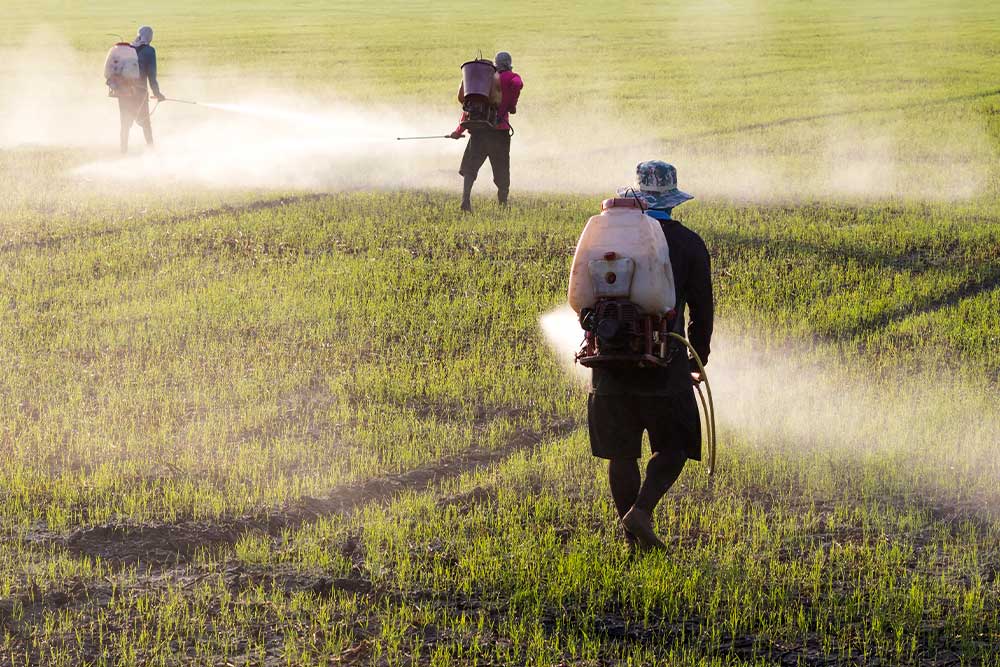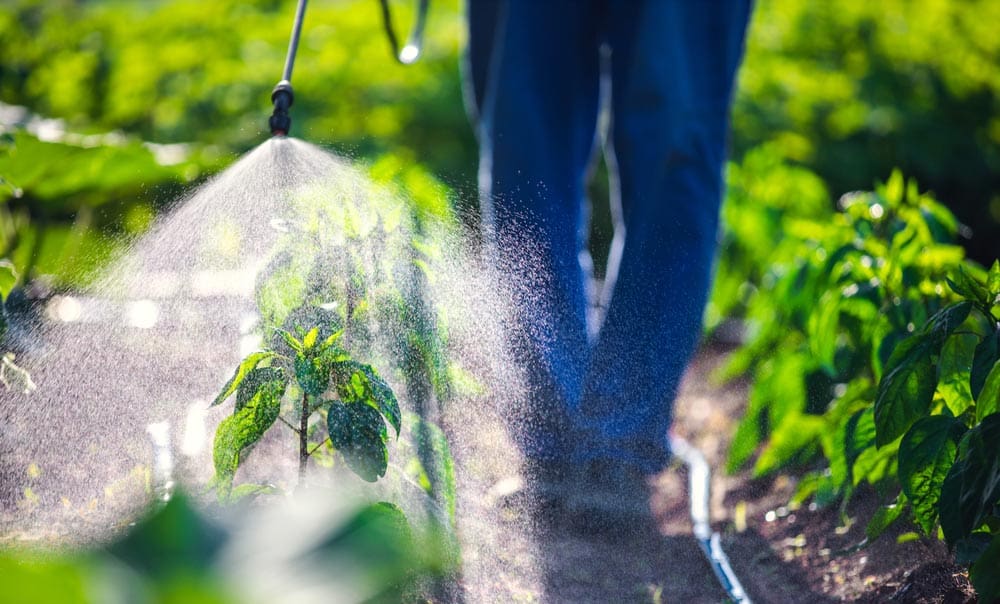Paraquat was first manufactured and marketed in the early 1960s under the name Gramoxone. In the years since, this chemical herbicide has gained wide popularity under brand names like Parazone, Para-Shot 3.0, Quick-Quat, Firestorm, Dexuron, and several others, because it is fast-acting and cost-effective. It’s also extremely dangerous.
Because of its high toxicity, the Environmental Protection Agency (EPA) classifies paraquat as a restricted-use chemical, meaning you must be licensed to purchase and apply it. The Centers for Disease Control and Prevention (CDC) also isn’t shy about how dangerous paraquat is if handled improperly. Yet, both bodies maintain that long-term exposure to the chemical poses no health risk.
Specifically, the EPA and CDC concluded there is insufficient evidence linking long-term paraquat exposure to Parkinson’s disease. However, multiple studies before and since these reports found just the opposite. A mountain of evidence suggests those who come into regular contact with paraquat, like farm workers, are at a significantly higher risk of developing Parkinson’s disease. As a result, many people have come forward to file suit against paraquat manufacturers like Syngenta, alleging that using paraquat led to their Parkinson’s diagnosis.
If paraquat is dangerous enough to be banned in over 30 countries, why is it still so popular here in the United States? And how will its continued use impact current and future lawsuits? Let’s dive into the history of paraquat and paraquat litigation to gain a better understanding.
What Started Paraquat Herbicide Lawsuits?

In recent years, here in the United States, we’ve sprayed about 7 million pounds of paraquat over nearly 15 million acres of land, despite its acute toxicity. Governmental agencies may think they have done enough by restricting its use and application, but the many lawsuits filed against paraquat manufacturers tell a different story.
“Restricted Use” Doesn’t Go Far Enough
In 2007, the European Union banned paraquat after finding that a previous decision to allow it was based on the false notion that it had no neurotoxic associations. Officials believed more consideration should have been given to studies that suggested paraquat could increase a person’s risk of developing Parkinson’s disease.
In the United States, our governmental agencies have fallen short of issuing a ban. Instead, paraquat is classified as a restricted-use chemical. This limits who can buy and apply the herbicide. The classification is based on paraquat’s extreme toxicity.
Obviously, something so poisonous is dangerous when ingested or inhaled. But these restrictions don’t go far enough to protect workers, their families, and communities from the health effects of long-term exposure. The EPA maintains there is not enough evidence to confirm a link between paraquat and Parkinson’s disease. However, many scientific reports and ensuing lawsuits demonstrate a credible association between the two, and even suggest the impact extends beyond those who are licensed and thus more likely to come into direct contact with paraquat.
For example, those who live near commercial farms where the chemical is used may be affected by spray drift. Likewise, family members of commercial farmers or agricultural workers may unknowingly come into contact with contaminated clothing or equipment.
The Science Behind the Claims
In 2011, the National Institutes for Health and the Parkinson’s Institute and Clinical Center teamed up to issue a report on paraquat and rotenone, another common pesticide. For the study, scientists used data from 110 Parkinson’s patients and 358 matched controls from the Farming and Movement Evaluation Study (FAME). FAME is part of a larger study of farming and the health of 90,000 licensed pesticide applicators and their spouses.
It concluded that the two chemicals are indeed associated with Parkinson’s disease. Paraquat “increases production of certain oxygen derivatives that may harm cellular structures,” explained Freya Kamel, Ph.D., a co-author of the paper. This mechanism specifically was linked to the increased risk of Parkinson’s.
Importantly, in releasing the report, the National Institutes of Health also pointed out paraquat’s role in animal-based studies. It’s one of only a handful of chemicals used to produce models of Parkinson’s disease in animals.
For example, a Buck Institute for Research on Aging study revealed a connection between paraquat and iron exposure in infancy to the development of Parkinson’s disease in mid-life for lab mice. These results are alarmingly similar to another study in California, which found individuals exposed to paraquat as a teen or young adult were between 200 and 600 percent more likely to develop Parkinson’s disease later in life.
Another California study found that residents of Central Valley under the age of 60 who lived near fields where paraquat was used between 1974 and 1999 had Parkinson’s disease at a rate many times higher than other residents in the region.
The Fight for Justice Begins
Studies like those mentioned above, coupled with other countries’ decisions to ban paraquat entirely, gave many people hope and courage to come forward with their stories. Plaintiffs allege that exposure to paraquat, and the manufacturer’s failure to properly warn users of its potential effects, led to their Parkinson’s diagnosis. Syngenta and Chevron Phillips Chemical Co. are the main companies named in these suits.
Most lawsuits are from commercial farmers and agricultural workers who were exposed on the job. Some plaintiffs are filing claims after being exposed to chemical drift and water contamination.
Which Illnesses Are Linked to Paraquat Exposure?

While some studies have linked a few illnesses, including kidney disease, to paraquat exposure, the most common is Parkinson’s disease. This is where the bulk of research and controversy is focused, and it’s the main reason people are coming forward to demand compensation from negligent corporations.
What Is Parkinson’s Disease?
According to the Parkinson’s Foundation, Parkinson’s disease is a neurodegenerative disorder with no known cure. It affects the dopamine-producing neurons in the substantia nigra area of the brain, leading to a broad range of symptoms that typically develop slowly over the years.
In lab settings, scientists have observed paraquat’s ability to destroy dopamine-producing neurons in the substantia nigra, further supporting the chemical’s link to Parkinson’s.
Although Parkinson’s disease on its own is not fatal, a person may experience other dangerous or even deadly complications as a result of their Parkinson’s diagnosis. For example, those diagnosed with Parkinson’s are believed to have an increased risk for developing melanoma, an invasive type of skin cancer.
Parkinson’s disease can also be accompanied by other non-fatal issues, like bladder problems, constipation, sleep disorders, trouble chewing or swallowing, depression or other emotional changes, and cognitive difficulties like dementia.
Symptoms of Parkinson’s Disease
It’s been said that no two people have the same Parkinson’s disease. Symptoms and progression vary widely. According to the Mayo Clinic, it can begin with something as simple as a barely noticeable tremor in one hand. Typically, symptoms affect movement and may begin in just one side of your body early on, worsening as time goes on.
- Tremors, usually beginning in a limb, often hands or fingers
- Slowed movement
- Rigid muscles
- Imparied posture or balance
- Loss of automatic movements
- Speech changes
- Writing changes
Who Can File a Paraquat Lawsuit?

The majority of plaintiffs’ paraquat lawsuits have been diagnosed with Parkinson’s disease. Most claims involve applicators, mixers, and field workers, but injured groups can include those affected by drift exposure. Here is who may qualify for a paraquat lawsuit:
- Anyone who had been exposed to and has used paraquat pesticide for more than four years
- Anyone who is officially diagnosed with Parkinson’s disease due to known and confirmed paraquat exposure and currently undergoing treatment/medication
- Anyone who is officially diagnosed with Parkinson’s disease due to known and confirmed paraquat exposure but has not been required to undergo treatment/medication
- Anyone who has been diagnosed with Parkinson’s disease in 2009 or later
- Anyone who lost a loved one to Parkinson’s disease due to known and confirmed paraquat exposure
The Government’s Response to Paraquat

As noted, at least 32 countries have banned paraquat entirely. This includes China, the world’s largest producer of paraquat, and Switzerland, where Syngenta is headquartered. What’s being done in the United States to protect its citizens from the dangers of this pesticide?
Protect Against Paraquat Act (2019)
In 2019, a bill was proposed to require the EPA to cancel the registration of all uses of paraquat, ban sale and use of the chemical, and to ban paraquat residue on food. It was introduced in the House of Representatives and stalled there for good, never receiving a vote.
Protect America’s Children from Toxic Pesticides Act (2020)
In 2020, Senator Cory Booker introduced a bill to the Senate aimed at amending an existing federal statute, the Federal Insecticide, Fungicide, and Rodenticide Act, to fully protect the safety of children and the environment, to remove dangerous pesticides from use, and for other purposes. To achieve that, it would ban the most damaging pesticides that have been proven to harm humans and the planet, including paraquat. This bill also never went to a vote.
EPA Mitigation Measures (2021)
Although the EPA has stopped short of a full ban of paraquat, it continues to review and reassess the chemical’s registration. In 2021, following pressure from the public, the EPA announced it would require mitigation measures to reduce health risks associated with paraquat exposure, although it did not mention Parkinson’s disease. Rather, the measures are meant to prevent severe injury and/or death from ingesting paraquat:
- Limit aerial applications to a maximum of 350 acres per applicator per 24-hr period for all uses except cotton desiccation;
- Require a residential area drift buffer for all aerial applications;
- Prohibit use of human flaggers;
- Prohibit pressurized handgun and backpack sprayer application methods;
- Require enclosed cabs if area treated in 24-hour period is more than 80 acres;
- Require enclosed cabs or PF10 respirators if area treated in 24-hour period is 80 acres or less;
- Require mandatory spray drift management label language.
Manufacturer Response to Paraquat Lawsuits
Despite the controversy surrounding paraquat, it continues to be widely manufactured and exported today. Syngenta maintains it is a “safe and effective herbicide when used as directed on the label.” Chevron stopped distributing paraquat in 1986, but has remained a defendant for cases involving paraquat exposure prior to 1990. In 2021, in response to a multi-district litigation forming in Illinois, Syngenta and Chevron moved to have some cases dismissed, alleging that they were invalid based on statute of limitation rules or other laws.
Both companies have issued little in the way of statements that directly address paraquat’s link to Parkinson’s disease. For the most part, comments focus on the importance of handling the chemical properly and avoiding poisoning through ingestion.
It’s important to note that we don’t have a clear picture of Syngenta’s conduct as it pertains to paraquat and Parkinson’s. So far, we’ve seen no evidence to suggest an anti-legislation campaign or science manipulation. However, internal documents revealed troubling details around the company’s apparent efforts to make paraquat safer for acute poisoning. It will be interesting to see what is uncovered during the Parkinson’s litigation.
The Paraquat Verdicts So Far
In many ways, paraquat litigation is just heating up. As the number of lawsuits rises, litigation has been consolidated as an MDL in the Southern District of Illinois before Chief Judge Nancy Rosenstengel. As of March 2022, there were nearly 900 cases filed in the MDL, with the first bellwether trial expected sometime later this year. Here are a few examples of claims filed, including some that have been consolidated into the MDL.
Holliday et al. v. Syngenta et al. (2021): Doug Holliday, a farmer in Iowa, filed a class action lawsuit against Syngenta and Chevron USA for putting people at increased risk of developing Parkinson’s disease and failing to warn them. He has used paraquat on thousands of acres of crops since the 1990s.
Pratt v. Syngenta et al. (2021): Ellis Pratt of Illinois filed a lawsuit claiming long-term exposure resulted in his renal disease diagnosis. Pratt says he was directly exposed to paraquat, drank water contaminated with paraquat, and was exposed through pesticide drift for 11 years.
Adams v. Syngenta et al. (2021): Robin Adams suit claims that, “Syngenta has long misrepresented and denied the harmful side effects of its Paraquat-based product.” She developed Parkinson’s disease after over 15 years of exposure to pesticide drift, direct exposure, and water contamination. Her husband was a licensed applicator, and both of them regularly used paraquat products.
Paraquat Lawsuit Settlement Amounts

When verdicts start being handed down in these cases, you can expect them to vary greatly. Every paraquat case is unique, so there will be no fixed settlement amount. In addition to the main details of the case, things like age, health conditions, and the ability of a plaintiff to prove how often they used or were exposed to paraquat will play a role. The fact that cases are being consolidated into a federal MDL will also affect settlement amounts because they will not be settled individually.
Factors That Affect the Paraquat Lawsuit Settlement Amounts
While each paraquat case is very different from the next, there are some common factors we can point to that help us better understand potential settlement amounts.
- Previous, ongoing, and future medical costs
Plaintiffs exposed to paraquat may be eligible to recover the costs of past, present, and even expected future medical bills related to their Parkinson’s diagnosis. It’s also reasonable to expect the long-term physical and emotional suffering that happens as a result could lead to higher-than-usual medical bills. All this factors into a settlement decision.
- Lost income
Suffering from Parkinson’s disease after exposure to paraquat can cause victims to be unable to work and provide for their families as their disease progresses. Although some plaintiffs can receive treatment for Parkinson’s, there is no known cure. It’s possible they won’t be able to work in the same capacity as before. In some cases, victims are left completely disabled. Settlements may account for this.
- Pain and suffering damages
Prolonged illness and, of course, the death of a loved one can cause severe emotional and mental distress. This is more difficult to quantify in court, as there often are no bills or receipts to look to. But these factors are no less important and worthy of restitution.
- Loss of joy of living
If a Parkinson’s diagnosis renders a victim unable to enjoy life like they once did, perhaps because they are now permanently disabled as a result, they can pursue damages to compensate for the ways the disease has affected their life.
Why Would You Choose a Paraquat Settlement vs. Trial?
Pursuing a paraquat settlement versus taking the manufacturer to trial may not be the best decision for everyone. But in some cases, this course of action can be more beneficial than a long, drawn-out litigation.
- Guaranteed payout
In a paraquat lawsuit settlement, the compensation is guaranteed once both the plaintiffs and the defendant agree on the terms. Taking on a multi-billion dollar company is time-consuming and costly, so a settlement can be a favorable option.
- Avoiding the additional financial burden
Not everyone who brings forward a paraquat lawsuit can afford to pursue a verdict in court. Even defendants aren’t willing to spend more than they need to in legal costs.
- Saves time
The legal system can sometimes move at a glacial pace. Unfortunately, many paraquat plaintiffs do not have time on their side. It could be months or years before a trial verdict is reached. A settlement is often quicker.
- Convenience
Another advantage of a paraquat settlement is the opportunity for the plaintiffs and defendant to structure the settlement in a way that works for both of them. This may involve the defendant agreeing to pay a settlement in installments, rather than in a lump sum.
- Preventing a negative verdict
There are two types of valuation used to determine the settlement amount in paraquat cases: trial value and settlement value. The trial value is the amount you expect the court to award, while the settlement value is the amount the plaintiffs hope to settle their paraquat cases for.
These values are rarely equal to each other. Because victims are settling a paraquat case to avoid the risk of losing at trial, the settlement value will always be much lower than the trial value. But even though the settlement value is less than the trial value, at least the compensation is guaranteed.
Latest Updates on Paraquat Lawsuits

As of March 2022, there are nearly 900 cases filed in the MDL of the Southern District of Illinois. This number will only continue to grow. Plaintiffs mostly consist of those who were licensed to use paraquat, thus they were directly exposed to the chemical. However, cases can also include some who experienced pesticide drift exposure.
That same month, 16 cases were identified for the first round of bellwether trials slated for November 2022. Plaintiffs chose eight, while Syngenta and Chevron chose four each.
Key Takeaways for a Potential Paraquat Lawsuit
Litigation is still in its very early stages, meaning now is the opportune time to file a claim if you believe you have one. The bellwether trial in November will give us a better idea of how future cases will play out. In the meantime, you can find out if you may qualify for a settlement.
Join the Many is here to provide a free, no obligation case review to determine if you may be eligible for a settlement. If you are, we’ll carefully match you with the best attorney for your case. There are no legal fees unless you win compensation. Contact us today to get started.




